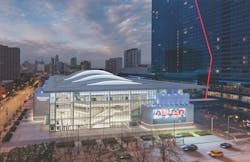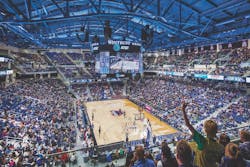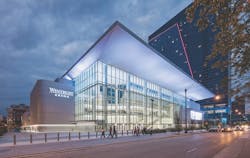Dream delivered: McCormick Square Marriott Marquis and Wintrust Arena
For anyone who has attended a trade show or industry event at Chicago’s massive McCormick Place—the nation’s largest convention center complex—a memorable moment might have been the frightening sight of the taxi line at the end of the day’s events. Walking anywhere in the South Loop neighborhood—to find a restaurant, head back to the hotel to freshen up, meet colleagues for a drink—meant trading in those dress shoes for a pair of cross trainers, because you were in for a trek. The only other option—before Uber and Lyft, of course—was waiting 45 minutes to an hour in a taxi line that regularly stretched a football field or longer during peak times.
In recent years, the city has invested heavily to inject life into the convention center district. The South Loop is booming, and the area immediately surrounding McCormick Place, known as McCormick Square, is finally starting to turn the corner. It’s common to see groups of convention-goers walking to nearby restaurants, hotels, and other amenities. And that dreadful taxi line? It’s a fraction of the size these days (thank you, Uber and Lyft!).
The city’s latest investment in McCormick Square is perhaps its most audacious move yet: a $500 million sports and hotel complex a block west of the convention center. The project, more than four years in the making, adds a much-needed second major hotel to the neighborhood and a 10,387-seat arena for DePaul University’s men’s and women’s basketball teams and the city’s WNBA team, the Chicago Sky.
Presidential Suite bathroom. Isaac Maiselman Photography.
The 40-story, 1.2 million-sf Marriott Marquis Chicago includes 1,205 guest rooms and suites and numerous amenities: below-grade parking, retail space, banquet and meeting rooms, ballrooms, a fitness center, and a restaurant and bar. It brings another walkable urban experience to the neighborhood.
As part of the hotel construction project, the team renovated the historic 1912 American Book Company building, which was once threatened with demolition. The five-story industrial structure is connected to the hotel and houses meeting room spaces and back-of-house areas.
A pedestrian bridge links the hotel to the 300,000-sf Wintrust Arena. Designed for sports, concerts, and other entertainment events, the arena features 22 suites, 479 club seats, team and support service spaces, broadcast facilities, and food and beverage concessions. It is wrapped in glass and translucent materials to activate the streetscape and to bring light deep into the interior spaces.
The design-build team of Prairie District3 Partners (PD3) constructed both buildings in just 25 months, and under the original cost estimate. The PD3 team included: Bulley & Andrews, Clark Construction Group, Goettsch Partners, McKissack & McKissack Midwest, Moody Nolan, and Old Veteran Construction. Pelli Clarke Pelli Architects (PCP) and Gensler served as the bridging designers on Wintrust Arena and Marriott Marquis, respectively.
The project included some 1.5 million sf of work on a single site, entailing a wide range of elements: new construction, renovation, high-rise, sporting venue, bridge/pedway, stormwater mitigation, and historic preservation.
Designed by Pelli Clarke Pelli Architects, Wintrust Arena, with its distinctive arched roof and transparent façade, is a new signature sports and entertainment venue for the city and another draw for Chicago’s McCormick Place convention center district. Jeff Goldberg/ESTO.
SOLVING COST OVERRUNS
The project team was put to the test early on, when cost escalations and refinement of construction estimates put the project millions over the original budget. The booming Chicago construction market led to a shortage of skilled labor, increased demand for materials, and overall cost escalation. The ballooning price tag for the hotel and arena not only jeopardized Gensler and PCP’s design vision for the structures, it also raised concerns and suspicions about the viability of the development.
The Building Team went to work, seeking elements of the development that could be altered without reducing or eliminating programmatic components or impacting the architects’ design intent. The solutions included:
— Reconfiguring the hotel tower orientation from a taller, single-bar plan to a more efficient T-shaped wing layout. This allowed the team to downsize the tower by several stories.
— Raising the original below-grade bowl back up to grade level. This move alone shaved $20 million off the budget by eliminating the need for costly excavation, earth retention systems, waterproofing, and foundation-wall work. It also compressed the overall construction schedule.
— Simplifying Pelli Clarke Pelli’s distinctive arched roof structure for the arena by reducing the height and number of undulations. The roof displays the largest Chicago flag in the city.
Jeff Goldberg/ESTO.
“PD3’s creativity proved vital for achieving the desired high-quality look while maintaining a tight budget,” said Dave Olszak, Manager of Design and Construction n Wintrust Arena, Metropolitan Pier and Exposition Authority, the project’s client. “PD3 value engineered the Wintrust Arena, which saved $70 million, without changing the arena program.”
The team also delivered the arena ahead of schedule, just 23 months after groundbreaking.
GOOD NEIGHBOR
The project team worked closely with the surrounding neighborhoods and local community to leave a lasting impact beyond the added revenue and foot traffic from these new venues.
When the local city official, Alderman Pat Dowell, expressed the need for more open space in the area for recreation for local families, the team delivered a pocket park just north of the Marriott Marquis. The park replaced a vacant lot with 21,000 sf of green space, a playground, and a dog park.
To minimize the impact of stormwater runoff on the city’s overburdened sewer system, the team created a system to tie direct roof stormwater runoff into an existing 3,385-foot-long deep tunnel that transfers to Lake Michigan. This approach will help avoid sewer system backups that would impact homes in the surrounding neighborhoods.
Designed for sports, concerts, and other entertainment events, the arena features 22 suites, 479 club seats, team and support service spaces, broadcast facilities, and food and beverage concessions. Jeff Goldberg/ESTO.
In total, $160 million in construction contracts (32% of the construction budget) were issued at the prime and subprime levels to minority- and women-owned businesses. More than 967,000 hours were worked by minority workers, 72,000 hours by female workers, and some 821,000 hours by residents of the city of Chicago—including 134,000 hours by residents of the wards surrounding the site.
"It was the sensitivity to maintaining the design concept for each building—not least because the neighbors had bought into both concepts—that won PD3 the jobs,” said John Nicolls, Former Senior Director of Development, MPEA. “As design and construction went forward it was on a cooperative and consultative basis, with the result that MPEA got the buildings it wanted at a cost that it could afford, finished on time and within budget."
Building Team — Submitting firm, joint venture general contractor Clark Construction Group Owner Metropolitan Pier & Exposition Authority Design architects Gensler (hotel), Pelli Clarke Pelli (arena) Architects of record Goettsch Partners (hotel), Moody Nolan (arena) Structural engineer Magnusson Klemencic Associates JV design-build partners Bulley & Andrews, McKissack & McKissack, Old Veteran Construction
General Information — Size 1.5 million sf Construction cost $500 million Construction time December 2014 to September 2017 Delivery method Design-build





